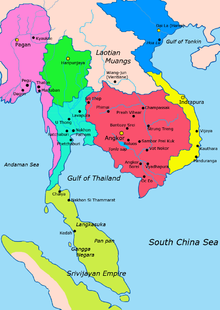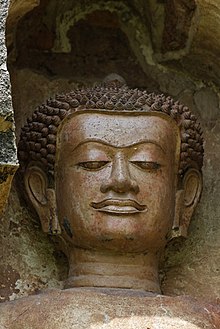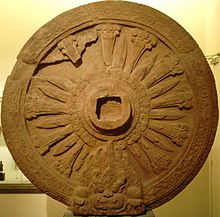Dvaravati

Dvaravati ( Sanskrit : Dvaravati , [dʋaːraʋatiː] ; Thai ทวาร วดี , RTGS : Thawarawadi, [tʰáʔwaːráʔwáʔdiː] ) is also sometimes described as an epoch in Southeast Asia and for a network Buddhist city states in the basin of Chao Phraya River ( Chao Phraya flow ), in the area of today's central Thailand , which existed from about the 6th to the 11th century. The ruling ethnic group were the Mon . The name Dvaravati comes from two silver medallions that were found under a sanctuary in Nakhon Pathom ( Central Thailand ) and on which the honorable deeds of the king of Sri Dvaravati are recorded. The most important city-states of the Dvaravati civilization were U Thong and later Nakhon Pathom and Khu Bua west of the Chao Phraya River and Lavo (today: Lop Buri ) east of the Chao Phraya.
In a narrower sense, Dvaravati only refers to the Buddhist Mon culture in what is now central Thailand's Chao Phraya Basin. In a broader sense, the culturally related, but different cultures of the Mon of Hariphunchai in today's northern Thailand and in the floodplain of the Mae Nam Mun and Mae Nam Chi rivers on the Khorat plateau in today's northeastern Thailand are sometimes included under this term .
history
In the 7th century Chinese chroniclers reported from a country "To-lo-po-ti", which was supposed to be west of Isanapura (in today's Cambodia ) and east of Sri Ksetra (in today's Burma ). It was assumed that the Chinese name is synonymous with Dvāravatī ( Sanskrit , roughly: "which has gates"). This was confirmed in 1964 when two silver coins were found during excavations at Nakhon Pathom . On one side of both coins the writing śrīdvāravaṯīsvarapunya , which means "meritorious deeds of the king of Dvaravati", was embossed. On the other side of one coin was a sailing ship, on the other coin a cow with a calf, symbols of prosperity and fertility. Dvāravatī (or Dvārakā) is also the name of the legendary capital of the god Krishna in the Indian Mahabharata epic.
The kingdom of Dvaravati probably came into being after the Funan empire disintegrated in the early 7th century .
The Angkor Empire appeared on the scene between the 9th and 11th centuries . From many inscriptions we know the political history of this empire as well as we know little about the disappearance of Dvaravati. It is likely that Angkor either captured some capital of whatever kind, or took the Dvaravati lands one by one, in order to take control of central Southeast Asia.
The most important cities of the Dvaravati empire, surrounded by a moat, were Nakhon Pathom with an area of 3700 × 2000 meters and the oldest foundation U Thong , which was settled at the beginning of the 1st millennium and covered an area of 1690 × 840 meters.
Urban planning and architecture
Archaeologists' findings let the Dvaravati civilization roughly be divided into three groups: the central group stretches along the edge of the central lowlands of Thailand, with findings mainly made in the valleys of Mae Klong and Ta Chin ( Nakhon Pathom , U Thong, Khu Bua ) and the Lop Buri and Pa-Sak rivers ( Lop Buri , Si Thep ). A north-eastern group spreads over the Khorat-Plateuau ( Mueang Sema near Nakhon Ratchasima and Mueang Fa Daet near Kalasin ) up to Phon Hong on the Vientiane plain. A northern group is centered around Lamphun (later the Hariphunchai kingdom).
It can be assumed that the cities of the Mon expanded along trade routes: connections from the Gulf of Siam to the west over the Three Pagoda Pass to Burma , to the north along the Mae Nam Chao Phraya up to Yunnan , in the east to north Vietnam are conceivable.
The old cities were surrounded by a round or oval moat. However, some were also in the shape of a sea shell, which the architect Sumet Jumsai calls “Conch City Planning”, which can still be seen in Lamphun today, for example.
Since the coastline was different at that time, some of the cities had direct access to the sea, but all were on rivers that could supply water for the moat. Irrigation canals did not only extend within the fortifications, an area that could be up to 10 km² in size, the surrounding area was also criss-crossed by canals, which suggests intensive agricultural use.
Larger Buddhist monuments stood on laterite foundations within the cities, on which a mostly square but also round or octagonal platform made of bricks was placed. The superstructure was also usually built from bricks. Finally everything was covered with stucco , a mixture of sand, lime and a glue binding, from which figures and other decorations could also be formed. An impression of such a structure can still be gained today at Wat Chama Thewi in Lamphun, where a square and an octagonal chedi have been preserved.
Form of government
Although very many inscriptions have been found in the Mon language, they say nothing about the administrative structure of the empire. "Reich" does not mean the modern meaning with a central control from a capital like z. B. Nakhon Pathom. It was more likely a loose confederation of autonomous principalities linked together through an intricate network of cultural and family relationships.
Several researchers confirm that the Dvaravati culture assimilated many elements of Indian culture , such as: B. Language ( Pali and Sanskrit ), religious beliefs (Buddhism), art and architecture, coinage and probably also the concepts of state and political organization.
The Thammasat (Pali: Dhammasattha , "Treatises on Dharma "), which (with minor adjustments) served as the basis for the Siamese constitution until the end of the absolute monarchy (1932), was created by the Mon of Dvaravati based on Indian models. The inspiration probably came on the one hand from the Digha-Nikaya , in which the (ideal) properties of a Chakravartin (“ruler of the world”) are written, but also from Kautilya's Arthashastra and possibly even from Manus Dharmasastra ( Manavadharmaśastra , literally: “Science of righteousness “, See web links), an ancient Indian text in Sanskrit about moral, ethical and social legislation.
Works of art
Dvaravati itself was strongly influenced by India . The empire played an important role in the introduction of Buddhism and, in particular, Buddhist-oriented art in the region.
Buddha statues


Buddha statues that have come down to us are all of a style and material that make them easily recognizable. They differ from both the Indo-Javanese school of Srivijaya and the classic Khmer style.
The material of the sculptures found in Thailand is not sandstone , which the Khmer preferred to use for their statues. Rather, it is a slate-blue, hard limestone that can be found in the hills east of Lop Buri and southwest of Ratchaburi . Judging by the number of bronze figures found, however, bronze was a material that was probably quite rare in the Dvaravati period. In addition, the Dvaravati artists were apparently not very skilled in dealing with bronze, as they were so masterly with stone.
The sculptures found mainly in Nakhon Pathom and Lop Buri , but also near Ayutthaya , can be divided into two types:
- The Buddha stands with his right hand raised, sometimes both hands are raised. Two statues of this type can be seen today in the courtyard of Wat Benchamabophit in Bangkok , others in the Phra Pathom Chedi Museum in Nakhon Pathom.
- The Buddha sits in the so-called European or Western style, both hands are raised and form the gesture of “turning the wheel of teaching”. He may also have raised one hand in the "gesture of instruction" while the other is on his lap. This species is unknown in Khmer iconography. The finest examples of these statues can be seen at the Phra Pathom Chedi in Nakhon Pathom, the Wat Na Phra Men in Ayutthaya and the National Museum Bangkok .
Both types can be compared to statues from the Indian Gupta period, but they can also be seen at the entrance to the Ajanta Cave Temple .
Features of the Dvaravati school are:
- very large but flat, spiral curls,
- a low, hemispherical, sometimes cylindrical Ushnisha (Sanskrit, for example "crest" ),
- large face of elliptical shape,
- emphasized upper eyelids, slightly bulging eyes,
- the narrow, slightly accentuated eyebrows in the shape of a "flying swallow" that extend from the bridge of the nose,
- the way of modeling an asexual body as if it were naked under a seemingly transparent, wrinkle-free robe.
A special type of Mon iconography, which has not been found anywhere else, are reliefs of the Buddha standing on a mythological animal ( Banaspati ). The meaning is unknown, but parallels to Hindu gods, who all have their special mount ( Vahana ): Vishnu on Garuda , Shiva on the bull Nandi, Brahma on the swan. Features of these mounts also appear on the mythological animal of the Buddha: the horns of a bull, Garuda's beak or the wings of a swan are depicted.
The meditating Buddha, as he is protected by the Naga king Mucalinda, was already made in Amaravati ( Andhra Pradesh ) and also in Sri Lanka . But as a novelty on the Southeast Asian mainland, such statues in the Virasana pose and the meditation gesture ( Dhyanamudra ) were introduced by the Mon here. This motif later became the preferred object of sculptors throughout the region, particularly the Khmer in the Angkor Wat and Bayon periods.
The stone sculptures of the Dvaravati school may appear a bit stiff, but they convince with “the purity and economy of their lines” and the lack of any unnecessary decoration. In short, they "breathe the pure spirit of Buddhism".
Law wheels
A special contribution to the Dvaravati sculptures is made by the large, free-standing wheel of Dharmachakra , the so-called "Law Wheel ", an aniconical symbol for the first sermon of the Buddha ( see also: Buddhist art ).
Wheels of this type have only appeared in Thailand so far. The first specimens were found 150 years ago during the restoration of the Phra Pathom Chedi ordered by King Mongkut . At first the meaning was unclear. At the beginning of the 20th century, French archaeologists took them for wheels on the large chariots of the “Brahmanic gods” or for boundary stones of temples. More bikes were later found in Nakhon Ratchasima Province, and others in Phetchaburi and Suphan Buri . Professor Cœdès ( École française d'Extrême-Orient ) finally explained that based on further finds of deer sculptures near the wheels, one could conclude that this was the symbolization of the "wheel of teaching" that the Buddha used with his initiated the first discourse in Migadayavana.
The stone wheels are made of the same material as the Buddha statues: bluish limestone, which turns slate-blue with age, a hard, smooth stone, wonderfully suitable for sculptures. Sandstone and even laterite were also used very rarely . The wheels were found in different sizes. The largest with a diameter of 1.95 m is now in the National Museum in Bangkok. The number of spokes is different, with individual wheels even the front and back differ. A Buddhist could see a symbol for the noble eightfold path in a wheel with eight spokes , and analogies can certainly be found for the other numbers (12, 16, 17, 18, 21 ...). But the artist probably did not want to refer to certain Buddhist laws by the number of spokes, he simply wanted to represent the wheel of teaching, and it is also impossible for the observer to count the number of spokes on a turning wheel.
The wheel circumference, the spokes and also the wheel hub are richly decorated with reliefs of flowers that show a Gupta influence, but also with Pali inscriptions. Almost all of the bikes are upright on stands. The stands have a variety of figural decorations, such as. B. Elephants (as water / rain symbol), deer (to remind of the deer park of Sanath) or deities who pay homage to the Buddha. Stands can also be designed in the form of an opening lotus bud. The square base suggests that the wheels were also placed on top of pillars in Thailand, as Emperor Ashoka had them set up throughout his empire. An example can still be seen today in the famous Temple of Sanchi .
Votive tablets
The largest number of finds from the Dvaravati period are certainly the votive tablets . The earliest tablets depict the Buddha as he miraculously converted the infidels of Savatthi. A rather large example of such a table can be admired in the Viharn Luang of Wat Suthat : under the Buddha statue of Phra Sri Sakyamuni, the remains of King Ananda Mahidol are buried behind such a table. Not all the boards found are that big, most are between 5 and 15 cm high. In the later period they are round or oval and show the meditating Buddha, sometimes with a Dhammachakra, sometimes protected by the heads of the Mucalinda. On the back there are Pali inscriptions in Mon script.
music
A cultural influence of the Buddhist empire Srivijaya on Sumatra and up to the 11th century of the Khmer of Angkor can be assumed for the 9th century . No contemporary texts have survived that deal directly with the music and dance of Dvaravati. In the “New Tang Annals” ( xīn táng shū , published in the first half of the 11th century by Ouyang Xiu ) there is a description of a Pyu orchestra, whose 35 members traveled from Burma to China in 802, and there twelve pieces of music performed with Buddhist content. Their musical instruments differed from those of the later Burmese orchestras, but some appear in reliefs by Dvaravati. At Wat Phra Pathom Chedi, a bronze hand bell was found that was originally attached to leather straps and was used to beat the beat. Dancers presumably held small cymbals in their hands, these can be seen in two stucco reliefs on the stupa of Ku Bua ( Ratchaburi province ). The Pyu orchestra did not have a five-string short-necked lute , as is also shown in Ku Bua. This type of lute is known from Amaravati (2nd century AD) and Pawaiya (near Gwalior , 5th century). From India to northern China this lute probably came in the 6th century via Kuqa and on to Japan in the 7th century. Like the lute, there was very likely a bow harp in Dvaravati, which was widespread in Asia at the time and is only preserved today in the form of the Burmese saung gauk . Analogous to the Pyu orchestra, the musicians in Dvaravati probably played a mouth organ , a three-stringed short lute, a kind of zither , various flutes and drums. Beat idiophones with tuned humpback gongs or metal plates have probably not yet existed.
literature
- Robert L. Brown: The Dvāravatī Wheels of the Law and the Indianization of South East Asia. Brill, Leiden 1996, ISBN 90-04-10435-6 .
- Pierre Dupont: L'archéologie mône de Dvāravatī. 1959, 2 volumes, English translation: The Archeology of the Mons of Dvāravatī. White Lotus Press, Bangkok 2006.
- Dougald JW O'Reilly: Early Civilizations of Southeast Asia. AltaMira Press, Lanham MD 2007, chapter "The Mon Protostates: Dvaravati and Myanmar", pp. 65-90.
- Dhida Saraya: (Sri) Dvaravati. The Initial Phase of Siam's History. Muang Boran Publishing, Bangkok 1999, ISBN 974-7381-34-6 .
- Praon Silapanth: Dvaravati Settlements on the Phetchaburi Paleo-shoreline. In: Uncovering Southeast Asia's Past. National University of Singapore Press, Singapore 2006.
- Steve Van Beek: The Arts Of Thailand . Thames and Hudson, London 1991, ISBN 0-500-23620-8 .
- Dhanit Yupho: Dharmacakra, or the Wheel of the Law. (1965), 5th edition, The Fine Arts Department, Bangkok 1990.
Web links
- Lanna Architecture Center. ( Memento from December 30, 2005 in the Internet Archive ) Chiang Mai University (photos of Dvaravati art, architecture and urban planning)
- English translation of Manus Dharmashastra ( Memento of February 6, 2006 in the Internet Archive )
Individual evidence
- ↑ Maurizio Pelleggi: Thailand. The worldly kingdom. Reaction Books, London 2007, p. 38.
- ↑ Himanshu Prabha Ray: The Axial Age in Asia. Archeology of Buddhism (500 BC-AD 500) . In: Miriam T. Stark (Ed.): Archeology of Asia. (Blackwell Studies in Global Archeology, Volume 7) Wiley-Blackwell, Hoboken 2005, p. 319
- ↑ Sumet Jumsai: Naga, Cultural Origins in Siam and the West Pacific. Oxford University Press, 1988, ISBN 0-19-588880-4 , pp. 149-154; Clarence T. Aasen: Architecture of Siam. A Cultural History Interpretation. Oxford University Press, 1998, p. 31.
- ^ Reginald Le May: Buddhist Art in South-East Asia. The Indian Influence on the Art of Thailand Cambridge 1937. Reprinted from Aryan Books, New Delhi 2004, ISBN 81-7305-260-3 , pp. 25-26.
- ↑ Dhanit Yupho: Dharmacakra. 1965
- ↑ David Waterhouse: Where did Toragaku come from? In: Allan Marett (Ed.): Musica Asiatica 6. Cambridge University Press, Cambridge u. a. 1991, pp. 90f


